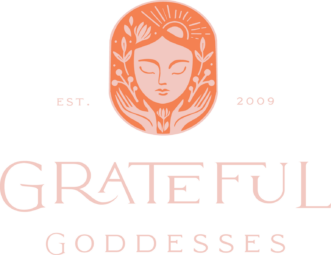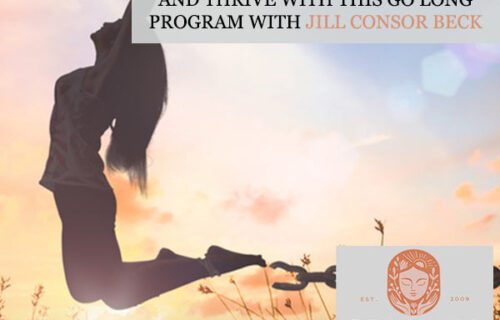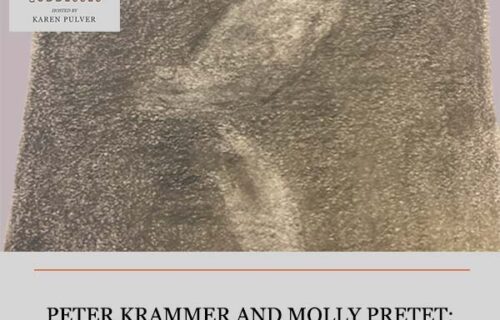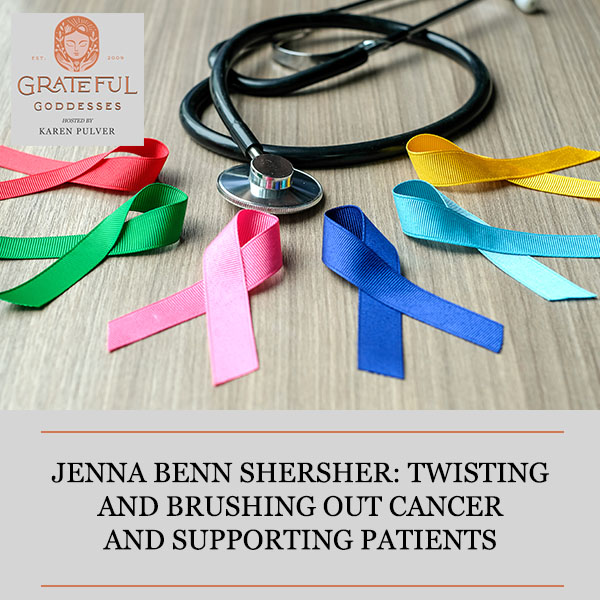
Jenna Benn Shersher: Twisting And Brushing Out Cancer And Supporting Patients
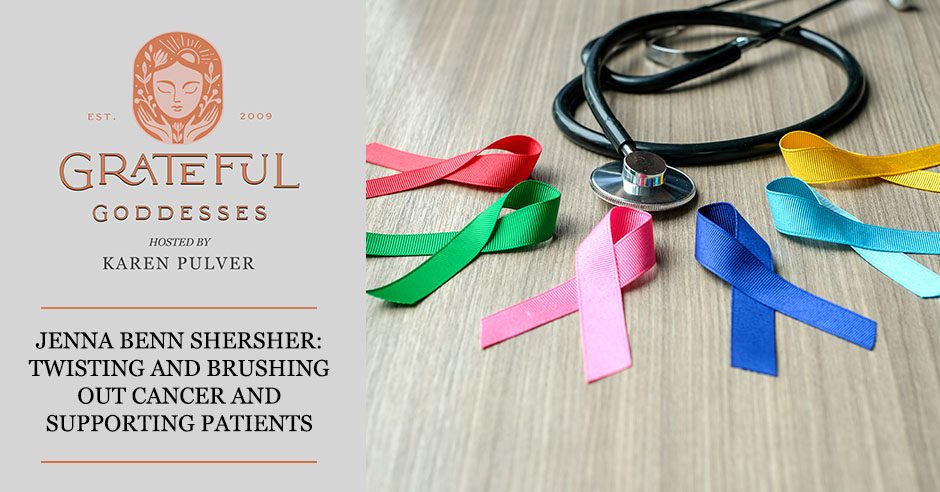
When we are vulnerable, by being open and honest, we can encourage others to feel like they have permission to do that as well. And when we can share our stories, we can support each other through life’s challenges. Support systems can come in many forms: a loved one, a stranger, a community…any place or person that hears you and helps you cope. In time, we can all build up our toolbox with the proper tools and experiences that can help to propel us forward. When I had my own cancer diagnosis ten years ago, it was a shocking experience that felt like it hit me suddenly. Once I started to go through my treatment, little did I know that my “Goddess Toolbox” was already full of rituals, experiences, and support that I had gathered over the years of participating in the many in-person Goddess events here in Chicago. I had learned yoga, meditation, breathwork, and how to add fun and folly into my life. When we are faced with tragedy or illness, we turn to our toolbox to help us through while also reaching out for support.
Jenna Benn Shersher is no different. When she had her cancer diagnosis nine years ago, she, too, reached into her toolbox and used what she had learned in her life to helping her through and along her journey. She realized that she needed support. Jenna then took this journey one step further by sharing her cancer story in a blog format, which, as it went along, turned into a fun initiative called Twist Out Cancer. She took a video of herself twisting and encouraged others to do the same. This initiative grew and developed into another that she founded called Brushes with Cancer. Join us to listen to Jenna’s story of how support, encouragement, and tools can help you heal and grow.
—
Watch the episode here
Listen to the podcast here
Jenna Benn Shersher: Twisting And Brushing Out Cancer And Supporting Patients
Thank you for joining us on Grateful Goddesses. We’re excited because we’re going to talk a lot about support. It’s so important, especially when you’re going through an illness to support each other and to help each other through that. When you’re sick, as I was years ago, I needed to know that someone was there for me. When I was going through treatment, I had people calling me to check up on me and I didn’t have any energy to spend time with people, but I knew that my close circle of friends and family were always there for me.
Jenna Benn Shersher is a cancer survivor, civil rights advocate, world traveler, and tiny twister who dreams big. In December 2010, Jenna was diagnosed with a rare blood disorder called gray zone lymphoma, which at the time, affected fewer than 200 people. Instead of surrendering to cancer, she was determined to find meaning in her suffering. In the course of her fight, Jenna figured out creative ways to leverage social media to process her experience and in turn, it creates a community that became invested in her fight.
In the course of a year, Jenna battled cancer and founded the nonprofit organization Twist Out Cancer. Jenna is the CEO of Twist Out Cancer which is an international nonprofit charitable organization that provides psychological support to individuals touched by cancer through creative arts programming. The organization was founded on the principle that when you share, the world opens up. What started in 2012 as a small art exhibition in Chicago for twenty inspirations and artists has become an international program that has touched over 30,000 people around the world.
—
Thank you for joining us, Jenna, on Grateful Goddesses.
Thank you so much for having me.
Thank you so much for coming. How was your gala?
It was amazing. We didn’t know what to expect. Obviously, this is all new territory for us. We’re used to having these large-scale gatherings with a couple of hundred people. This was also the first time we were working with a corporate partner. The program that we ran, Brushes With Cancer, took place at General Motors Design Center. It was an internal program with their participants. We didn’t have a bar. We didn’t know what to expect but it was amazing. It shows you that with thought, care, the right resources, and the right people involved that you can create intimate and meaningful connections even if it’s done virtually. It was beautiful. I think there’s also some benefit to having pre-recordings of things where we can share it out, so if people couldn’t attend in person or live through Zoom, we were able to then share the YouTube clip, which was wonderful.
Your ability to connect with others is so evident, especially in your initiative Twist Out Cancer. Can you talk about your journey and how you developed this initiative?
With support, thought, care, right resources, and people, you can create intimate and meaningful connections even if done virtually. Share on XIt was done pretty organically. There was not a ton of thought that went into this, at least initially. Back in 2010, when I was 29, I was diagnosed with gray zone lymphoma, which is a rare blood cancer that at the time, I didn’t even have any information about the disease. When I would go and google it, there was one Wikipedia page that said, “It has features of Hodgkin’s and non-Hodgkin’s lymphoma.” That was the extent of the information that was available to me. It was an isolating place to be as a 29-year-old with a rare type of cancer with no specific treatment regimen and no community.
Early on, I decided that I was going to write my own story. What I started to do was I started blogging, and I was very open and honest about my experiences with cancer as a young adult facing a rare type of cancer. As I started blogging, it was initially a private blog that was just out of necessity to update family and friends and then I realized in the process that I had left people out. I ended up opening it up because I felt like, “I don’t want to start sending out invitations to this thing. I’ll open it up. Whoever is interested will read it on their own time.”
Very quickly, the blog started taking off. I didn’t realize it because that’s not why I started this thing. It was out of need. Within a couple of weeks, there were thousands of people that were viewing the blog and I couldn’t figure out what was so interesting about this like why were people wanting to read along. I think there was a little bit of a fascination. I was young and I was being very open, honest, and real about my experiences but I also think that a lot of the topics that I was talking about were touching on a lot of nerves for people. It could be anything from not recognizing yourself in the mirror. I had people reading that had eating issues, like body dysmorphia, anorexia, or bulimia, that had struggled with their own self-perception.
I had a pen pal that was going through an abusive relationship that was trying to find the strength to get out of it. She was turning to the blog as inspiration for that. It was interesting that as I was writing, I wasn’t just impacting people that had cancer who currently were in treatment or post-treatment. It was people from all walks of life that found some type of fascination with what I was experiencing and how I was managing it.
As I was writing, I became, in some ways, like this keeper of secrets where people would feel like, because I was being so open and honest and vulnerable, that they then, in turn, had permission to do that. I felt like it was a real position of privilege that I was in because I felt like people were opening up with me but they may not be opening up with their family or friends about what was going on. I continued writing. It was a huge coping strategy for me and a place to process what I was experiencing. When I finished treatment for gray zone lymphoma, I was determined to give back to the community.
That need and desire to do something with this is what turned into Twist Out Cancer. I should also mention that as I was blogging midway through treatment, I was starting to feel a little overexposed. I was being open and honest, and then I was like, “I’m putting a lot out there. I don’t know who these people are that are reading. I don’t know people in India, Pakistan, and Australia.” All these foreign countries. There were certain ones that I had a sense of who was who but then it got too big. I decided that I wanted to see who these people were. I put out a crazy call to action on Facebook and on YouTube. It was of me dancing and I said, “Who’s joining me on the dance floor in twisting out cancer?” That’s where the name Twist Out Cancer comes from.
That’s cool. I know that for me, personally, when I had that diagnosis and I came home after seeing the oncologist, I just wrapped myself in a blanket and curled up in bed. I was so scared. My husband gave me a journal and said, “Just start writing.” At first, I resisted it but then when I started writing about what happened and the feelings, it was so cathartic. I can relate to that. I didn’t publish it or have others read it, but it was nice for myself to do. I know that’s such a great tool to do when you’re going through something like that. What was your life like before cancer?
My life was great. I was a healthy 29-year-old. I was working at the anti-defamation league. I had an amazing job there. I was their associate regional director, so what I was doing was running a lot of international programs. Leading trips all over the world like Germany, Austria, and tons of interesting places and bringing young adults to see and learn about anti-Semitism up close. Both from a historical perspective but also in modern-day times. It was a dream job. I got to travel the world. I was working with incredibly smart and creative people. I was in a relationship. I was working out regularly. I had a great setup and then the world came crashing down. It was insane.
I felt the same way. Did you wonder like, “What did I do wrong?” Did you look back at your life?

No. I didn’t go there.
That’s smart.
It’s not right or wrong. I think it was weird that I didn’t do that. I didn’t go into the place of, “Why is this happening to me?” I can’t explain to you why. Maybe I felt in some ways that my life is laid out or is somehow being guided. That might be influencing how I responded. I’ve always been a very spiritual person. Certainly, when I was sick, I was doing a lot more in terms of prayer and ritual. I never got to the place where I was like, “This suck. Why is this happening to me?” I did get to the place of, “This suck. This is horrible.” I never questioned why me and it made it easier because I figured that I needed to figure this out. I used every tool in my toolbox from thinking about how I prepped for final exams in college to making binders, highlighting, and organizing things. I used all of that to navigate my cancer journey. That helped but I think it’s unique that I didn’t get to that place.
It shows, as you said, you had a good toolbox already formed. I look back at my experience where we had Grateful Goddess gatherings during that time. I felt like I was learning and experiencing all these great things like meditation, proper nutrition, and even talking about learning how to set boundaries with your friends and family. Those were my tools that I then used later on once I got over that, “Why me?” I certainly did go through that, “Why me?”
If you can have that feeling of, “That’s not going to serve me. That’s not going to do anything for me. Let’s put it away or spend a few minutes and put it in a box.” I took a little longer and that’s okay. There’s no right or wrong, but obviously, what you had inside propels you forward to do all these amazing things. We’re going to invite our Featured Goddesses on to take part in this discussion because you are so fascinating and we love all the connections that you’ve made. Alyssa is going to start with her questions for you.
I want to find out more about this video that you made. This was the birthing of Twist Out Cancer. What were you expecting and why did you think that it resonated with so many people? It’s amazing to think that you just wanted to see what the people you were blogging with look like but it turned into so much more than that.
This was not thought through. The call to action came from a very desperate place. I was midway through treatment. I was severely immunosuppressed. I was in a studio apartment on Lakeshore Drive. Thankfully, I was able to see the lake and feel like there was some hope outside. I was too sick to see anyone. For weeks at a time, I was staying isolated, very similar to what we’re experiencing, and I think I was bored. I was honestly bored. When I put up this video, there was no editing involved. There was no doing another take. It was me in my apartment, putting on Chubby Checker’s The Twist. Getting up and just doing it. I didn’t even talk in it. I got up there and do the twist and my balance was so bad. It was off because I was so sick that I ended up knocking over the lamp.
It is a horrible video, but I think it’s honest. It was ridiculous and it was also before TikTok, Snapchat, and all these other channels that are clouding up everything. There were Facebook and YouTube that was the extent of social media at that point. They fed together. There was no paid advertising. It was like organic growth. All those things played into why the video got traction. Because I had been writing for so long and hadn’t been using video, it was a new method for me. People that were following along were like, “That’s what she looks like? That’s what it’s like at home for her?” Similar to what we’re experiencing with Zoom, they were like, “That’s what her place looks like?”
There was a bit of intimacy that was created by using video at the time. All those things played a role. What I was asking for was also easy. It was joining me on the dance floor. You didn’t have to be a good dancer. I was showing that my skills were horrible at that time. It was a call to action that was accessible to people no matter where they were at. I was getting videos from office parties, from bars and Bat Mitzvahs, and from weddings. I was brought into amazing gatherings all over the world. It was the perfect thing for me when I was sick because I’d be in the hospital and not being able to see people and all of a sudden, I felt so connected to these people. It was a beautiful thing.
I never questioned why me? I used every tool in my toolbox to help me navigate my cancer journey. Share on XWhat you did here was you tapped into sort of the psychosocial needs of cancer victims, caregivers, and everybody whose lives have been touched. That’s an important thing that you can talk about treatment, doctors, who to see, and what you see but you’re tapping into something with your organization that goes way beyond that. Can you talk a little bit about that? This was a new term for me. I’m getting ready to talk to you was the psychosocial needs of survivors, supporters, and their entire community.
When I finished treatment, I wanted to do something with this. The first thing that I did was I raised money for Leukemia & Lymphoma Society, which is an amazing organization. They are responsible for the drug that helped to cure me or to make me better, however, we want to talk about it. I did that and it got my feet wet with fundraising, even though I had a background in it through the anti-defamation league, but it wasn’t my own. It didn’t feel satisfying enough. I was happy that I did it and was able to raise awareness about an amazing organization but I saw very early on that there were a lot of organizations focused on research. This is so important but there was not a ton out there that was focusing on the emotional impact of a cancer diagnosis. Not just on the individual, but also on the caregiver, family, and friends that are involved in that person’s inner orbit because cancer doesn’t just affect that person. There are ripple effects essentially. I knew early on I wanted to focus on that.
I was also well-equipped to focus more on the emotional impact of things. My background was in social work. I grew up with a very emotionally charged family. My mom is a psychologist. My sister is a social worker. We were raised to be open and honest about our feelings. We didn’t shy away from those things. It was a combination of looking at the needs of individuals touched by cancer but looking at what was already out there in the community who was being served by those organizations and what was the unique twist that I could offer into what was already out there. Competing with organizations that have been around for 100 years that are focusing on research, I had no interest in that. They’re doing amazing work and partnering with groups like that is so important. I felt that as a young adult facing a rare type of cancer, I wanted to focus on getting people to come forward and talk about their story and to feel like there was a safe place for them to do that.
Camille wants to follow up with that with a question about caregivers.
Jenna, nice to meet you. From my own experiences being a caregiver when my mom was going through breast cancer, it was so important for me realizing that you included everyone touched. As you mentioned, the entire orbit that surrounds the patient that’s going through cancer. What are some tools or support you would like to see for that entire orbit? What were some of the things that helped you as a patient, but also your caregivers that were impactful?
I found that as I was going through it, there were so many resources being put towards me and towards patients but it was as if caregivers were being left out of the conversation. I remember I would go and check into Prentice Hospital for my six-day stint and no one was checking in on my parents, who were there all day and all night waiting with me. As much support as I needed, they also needed support along with my closest friends that were involved. I felt that caregivers, in particular, were these unspoken heroes that often didn’t get a seat at the table and deserved one. When we started to think about programming and resources for this population, it was immediate to me that I wanted to include caregivers.
I also wanted to include what we refer to as previver. People that are genetically predisposed to cancer. We hear a lot about BRCA1 and BRCA2. Women, for example, that’s getting screened because they have a higher risk of breast cancer or ovarian cancer. Some may even go through measures of going through a double mastectomy in order to prevent cancer from eventually coming into their lives. I felt that if people are willing to go through that and to be waiting for a diagnosis or even being proactive that they’re going through cancer treatment, then why are we giving voice to people that are touched in that way? It became very clear that we needed to be very comprehensive in the type of programs that we’re offering.
We have a program called Brushes With Cancer that matches artists with people that have been touched by cancer. We call people touched by cancer inspirations. Over a six-month period, the artist and the inspiration that we matched, we go through a strategic matching process, they connect. The artist is charged with creating a work of art that’s reflective of the inspiration’s journey with cancer. We’ve had so many caregivers and previvers that have been a part of it. We also have what we call survivors. They are not people that have been cured of cancer. I hate that word. It’s about people that have survived that experience of hearing you have cancer because your life is forever changed. That’s people in ten years out of treatment. I’m considering myself a survivor. I felt that I was a survivor as soon as I was diagnosed. It’s including all people from all walks of life and giving them an opportunity to share their stories.
Tina, you’ve attended one of the Brushes With Cancer events, right?
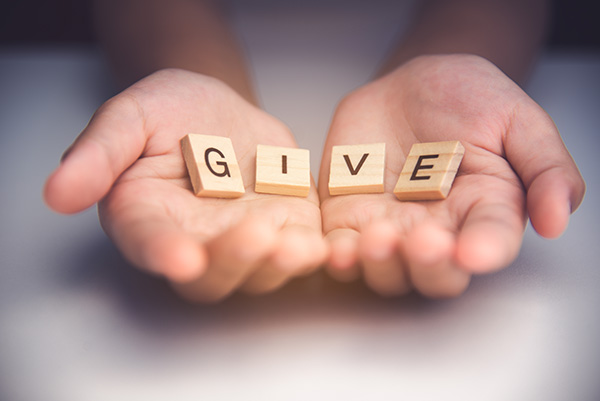
That was part of my question to you. Yes, I was fortunate a few years ago to attend. I have a very close family member that is on your board. She asked me to be paired up with an artist and then COVID happened. I didn’t hear much more about how your event is pivoting to still serve that. How are people matching with the artist? Is that virtual? Is it still happening? What has been the response from those that you have matched up, both survivors and caregivers? What’s the impact of COVID?
It’s interesting because we met with our board and we all came to the agreement that we wanted to move more into the virtual space. When we first started, it was a virtual experience. The first Twist Out Cancer website was people sharing their twist on cancer. Lessons learned, fighting strategies, new perspectives, and then putting out calls to action that were meaningful to them. One of our first calls to action was from this girl, Anna Moschner, who put out a call to action that was to create a unique work of art not using the shade of gray because gray was all that she was seeing. She had gray zone lymphoma like me. I met her through my oncologist.
It was because of that call to action that sparked the idea for Brushes With Cancer. We’ve been running this program now for years and we’ve done it twenty different times all over the world as of 2021. As we’ve grown and scaled the program, it’s got bigger and bigger, which is great because we can include more people, but it also leaves out a population that we intended to serve. The people that are severely immunocompromised and people that are going through treatment. Imagine you’re in the throes of treatment, you just got out of a chemotherapy cycle, and the event is happening, you may not feel comfortable coming into an event that has 500 to 600 people.
All of a sudden, we started thinking, “How do we integrate the virtual component, which is how we started into what we’re doing now in the community?” Thankfully, we started thinking about, “How do we beef up our online presence?” We got someone involved in SEO, which I know nothing about. We started hiring some people to help with some of the web piece of it and then COVID hit. In mid-March 2020, I made the decision that we were going virtual for the rest of the year. It didn’t matter if things got better.
We are dealing with arguably one of the most vulnerable populations. I didn’t want people to be having to make a choice about their safety and wellbeing to attend an event. It made no sense to me. Because we made that decision early on and we started in the virtual space, it wasn’t hard for us to get back to our roots. In some ways, it got us back to why this all started. Not that we had drifted from our mission, but you start to do things that become automatic and then you don’t have the time to think about, “Why are we doing this? Are we serving the people that we intended to serve?”
In some ways, it was a bit of a blessing that we have this time in January 2020 to think about how are we doing this. When March 2020 happened, we were a little bit better prepared than some other nonprofits to deal with it at least. We’ve been offering twist shops, which are art therapy workshops exclusively online. We were doing that weekly. They typically are only offered for people touched by cancer. We opened it up to anyone because we realized that some of these feelings of isolation, loneliness, fear, and uncertainty that’s happening across the board, you don’t have to have experienced cancer to be feeling that. That was a weekly occurrence on Tuesdays that we offered.
As far as Brushes With Cancer goes, everything is being done virtually. All the matches that were made, it doesn’t matter where you live or where you’re from because you’re connecting over Zoom, FaceTime, Skype, through text, or however is meaningful. In some ways, it’s been an interesting test study because I would argue that some of the connections that have been made in the months of COVID have been the most meaningful. The artist, in particular, that we choose doesn’t have to have a cancer background. A lot of them do.
I think people are hard-pressed to find someone that hasn’t been touched by cancer in some way or someone that knows someone. In this case, everyone was able to relate to the experiences of isolation and loneliness because they themselves were going through it. I would say that there was almost an increased sense of empathy between both parties that we hadn’t necessarily seen in prior years. I’ll be curious, we’re obviously going to assess all the participants at the completion of all these programs to see where they started and where they ended up, but the programs have been very successful in the sense that the relationships have been really beautiful.
If you notice, Camille’s background is a painting that her mother painted. Camille, you can talk a little bit about that.
Caregivers are the unspoken heroes. Share on XMy mom is an artist. She started art in college. She’s been doing it for a long time. Some years ago, she was diagnosed with breast cancer. During that time, she couldn’t perform art anymore because of all the different surgeries she had to do. She had to do it quickly due to insurance reasons. Being able to express yourself through art even journaling, all the different options that you give people to do, it’s important that people realize you don’t have to be an artist necessarily to get the enjoyment or to get out of your head to enjoy it. I love that you’re offering these different programs, especially now that you said you’re offering it to anyone, not just people touched by cancer. For my mom, what worked for her, because she needed to express herself still. She started creating earrings.
I was admiring them.
It’s learning to pivot and finding other ways to express yourself, even having a way for artists to give voice to people who don’t have that creative or they’re immune-compromised, they can’t. I love that you’re doing all of that. As an artist’s kid and also having the background with cancer, my uncle also passed with cancer, it affects a lot of people. When you were talking about caregivers, I’m an only child. It was just me taking care of her because my uncle had passed two years prior. These are the things that a lot of people overlook. Understanding how important it is to become that village and having places you can go when your village can’t because they’re still mourning the loss and it’s too close. I wanted to put in my little thank you that you’re offering this. I’m so glad it’s virtual because I’m far away.
Where are you?
I’m in North Carolina. Thankfully, we had Duke as our hospital to help out and I volunteer there.
Maybe we can get you guys involved in the next Brushes.
I’m definitely down. Are you offering it every week?
Twist Out, we offer every week, and then Brushes With Cancer, in 2020, it was three times. We have three different programs. We’ll have to see what 2021 is going to be like. We’ll start to roll out the application process in January 2021. If we’re going to be all virtual, which truthfully, the virtual piece will be here to stay, if things get better, which I hope they get better. Maybe we’ll do one in-person event, but I have to imagine that the virtual experience is going to be something that we continue to do. It doesn’t matter where people are. It’s amazing. We have an artist that’s in Germany that’s participating in our Chicago program. We have a lot of international people that will participate as one-offs but they’re not missing out by not being able to come to an event. The event is coming to them.
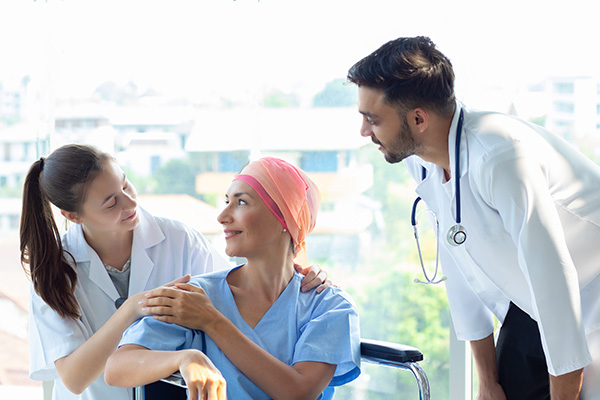
We had talked before about your connection with Imerman Angels. We had Jonny Imerman on a podcast and he explained the whole process. I had an angel. I am now an angel. Can you talk a little bit about your connection with that program?
Jonny is the best. Everyone feels this way. Anyone that knows Johnny, he’s one of a kind. I was in New York for two years during my Master’s. I ended up coming back to Chicago. As I started to reconnect with old friends and meet new people, everyone kept saying, “You need to connect with Jonny. You’ll love Jonny.” This was prior to cancer. I kept hearing about him but never had a chance to meet him. When I was diagnosed was like, “I better call this guy.”
I called him, he responded right away. Two days after I was diagnosed, I went and got tea with him. It was Christmas Eve. I was diagnosed on the 20th by the 23rd or 24th, I was with him having coffee and tea. He normalized it for me. It was so nice to meet someone that was a little bit older than me but young that he could tell me that it was going to be okay, and then he was going to connect me with people.
Not that he made cancer cool, but he made it less scary. Cancer, to me, was always an older person’s disease. I thought about it as something that my great uncles and grandparents had passed away from. It was not something that I would think about as a 29-year-old having. I didn’t have any other friends that had had it or that were dealing with it. Finding a cancer crew was important because then, I could talk about all the fun stuff that was happening during treatment that none of my prior friends knew how to respond to, deal with, or give me advice on. They’re not going to know what to say because I have mouth sores. Being able to talk to other people that get it was important.
I was initially matched up with a great guy named Benji Salter, who’s a physician in New York. He had Hodgkin’s lymphoma because initially, they had thought I had Hodgkin’s. He was great. He gave me a piece of advice. He said, “Jenna, find a hobby.” At the time, I thought that was the dumbest advice. It’s like, “I need to fight for my life. Why am I finding a hobby?” It made no sense to me. Looking back on it, that’s exactly what I did. I started writing. I started dancing. I started finding extracurricular outlets for myself to be able to manage what I was dealing with. I’ve done that also through COVID. I started getting back into guitar and things like that.
He’s someone that I stayed connected with. He’s a wonderful person, but then when my diagnosis changed and my treatment regimen became way more intense, they ended up connecting me with Ethan Zohn, who some people know as the winner of Survivor Africa. He’s been on lots of different reality TV shows. He was someone that I watched. I’m not the biggest Survivor fan but I did watch his season. I always thought he was amazing. He was so down to earth.
It was nice to talk to someone that had gone through my regimen of treatment, understood what I was dealing with, and was a couple of years ahead of me, and could say, “Here’s how you’re going to manage this. Here are my tips for you.” Unfortunately, he ended up relapsing about two years after I had finished treatment. Our roles ended up becoming reverse. Where he had mentored me, I then ended up mentoring him and dished back his advice to him. Somehow, it resonated with him as if he had never heard it. It was amazing.
Imerman Angels have been an amazing organization. Jonny, on top of having an incredible organization that he built has been a wonderful mentor to me. When I was starting Twist, I wasn’t sure what I was doing at all, even with a nonprofit background. I didn’t know where to start, and I had so many ideas. He was someone that I go out to lunch with and he would tell me straight up, “That exists. How are you going to do that?” He would ask me those hard questions in such a nice way. It was because of that I was able to get a lot of clarity and focus in on what I thought our mission should be. Having some type of mentor, he was a mentor to me both in the cancer space but also in the nonprofit world. He’s a dear friend.
Imerman Angels was an amazing program for me even when you talked about mouth sores. I remember, for me, it was, how do I talk to my children? What’s the best way to tell them? I was googling. When I did that, my older daughter found out because she used my computer and looked at my past history of what I was googling. She came upstairs and said, “What’s going on?” That was not how I wanted her to find out.
The unique twist that I could offer was to focus on getting people to come forward and tell their own stories. Share on XNeedless to say, the advice that the angel that I had was, “Be honest, don’t sugarcoat anything, and tell them exactly how you’re feeling, when you’re tired, when you’re upset because they’ll be there for you.” Even though it was years ago when they were in their early teens, they don’t want lies. They want to know the truth and it’s okay to say, “Everything is going to be okay, but maybe it’s not. If it’s not, we’re going to get through this. We’re going to be together and we’re going to help each other and support each other.” I loved that organization.
I also hear you when you said you then became the mentor for him because that’s happened to me as well with the woman that I’m an angel for. We help each other. One other thing I wanted to ask you, and I think I already know the answer because I can tell by your optimistic attitude, even when you were diagnosed. There’s always that feeling of reoccurrence, especially with Ethan. When that happened, there’s always this feeling that it could come back when you say cancer survivor. My oncologist said, “You’re not in remission. You’re not cured. You’re still on watch and wait so you’re cancer-free.” I don’t know if you’ve heard that, but that’s hard to hear. That’s like, “When’s it going to come back?” Every single time you get something, you’re like, “It’s back.” I’m curious how you deal with those thoughts, with the people in your head talking and saying, “It might come back?”
The way we talk about cancer is important. Language does matter. I remember I was out to dinner with someone that my husband knew. He was an oncologist. My husband works in cancer, too. He’s a cancer surgeon. It was someone that he didn’t know but I remember, inappropriately, he said to me, “You’re never cured of that. You’ll be monitored.” I remember thinking, “I don’t know you. You don’t get to say that to me. You know nothing about my disease or who I am.” That’s why, for me, talking about anyone that’s heard those three words as a survivor can be empowering.
Everyone’s journey is different. Not everyone gets to a five-year mark or ten-year mark. Even if you come up to those markers, there is always that fear that it could come back. For me, the best comparison, in the beginning, is that cancer was front and center for me. It was center stage and it consumed my thoughts. I was constantly thinking about my experience and the possibility of recurrence. With time and with more experience, it has become less front and center.
However, when I go and get ready for scans, when I see my oncologist, when I feel flu-like, or all of a sudden start having weird symptoms, of course, all of those fears come rushing back, even though I’m ten years out. That fear doesn’t go away because you’re used to having the shoe drop. You’re used to having your world turned upside down. For me, at least with time, it has helped in the healing process. I have been knocked down so many times. Cancer is one piece of my story. It was a big part but I have dealt with so many other serious things, whether it’s family-related or personally. Those experiences prepare you for the next tip. While I am, of course, terrified about a recurrence, the toolbox that I had years ago has only grown. I do believe that if I’m faced with another adverse situation, I have the tools but I also know how to ask for help and I’m not scared to do that.
Asking for help is crucial. Someone I know closely and dearly has said she did not want any help. She didn’t want to talk about it, and that’s fine. That’s her journey, but it was hard for her. Looking back in retrospect, she said to me, “I wish that I took the help. I wish that I took the meals.” People were there and they want to help you. If you’re reading, you’re struggling, and you’re going through this, indecision, should I ask or not? People want to help you. They want to support you, even a listening ear, a text, a little happy face text every day, those things matter. It’s important. Do any one of you have any other questions for Jenna? Yes, Camille.
I noticed on your website that you keep repeating the word resilience. You also mentioned how your daughter had an impact on how you changed with the program as well. I’m curious how you would explain to her the importance of resilience and looking back at your program, what you hope people get from it?
My daughter is five in 2020. She’s also precocious. She lives with two parents that work in cancer. We have not shied away from talking about it and talking about hard things. Obviously, I don’t go into significant detail with her because I also want her still to be a five-year-old and to see joy in everything which she does. One time at a gala, she was with me, she listened to the stories, she saw the art that was created. She asked to be introduced to everyone at the end of the event.
In terms of owning our stories and being open, honest, and vulnerable, we have tried to do that with her and show her at an early age that it’s okay to not be strong all the time and to be open and communicative about the hard. She has heard it from me. She asked me tons of questions about when I was sick. She looked at photos of me when I was sick. She’s asked why didn’t I have hair? What did it feel like? I have shown her that, but I haven’t shown her everything. I haven’t talked about everything. She also loves telling people that she’s a miracle too.
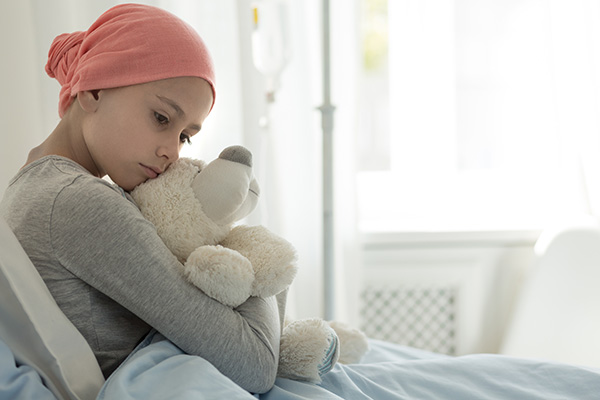
Not every family would opt to start that conversation that early, but it comes up at dinner when I’m talking to my husband about who he operated on. He’s dealing with lung cancer and esophageal cancer and there is a lot of loss. When we get ready for Shabbat on Friday night, we’re lighting candles, and we’re thinking about people that are sick. He talks about his patients and I talk about people that are involved with us it Twist and it’s a part of our ritual. My daughter knows that and she thinks about them and asks about them. We’re open about that.
Thank you. That’s amazing.
Jenna, if our readers want to contact you whether it be to give a donation or to take part in an event, how can they do that?
You can find me at Jenna@TwistOutCancer.org or check out our website, TwistOutCancer.org, or on Facebook and all the different platforms. Hit us up that way too.
Can we do a twist to end the show? Let’s twist again. We have to support each other. Thank you so much for twisting out cancer with us, talking about your journey, being vulnerable, showing us resilience, and how much support is so important, especially even with COVID. This is being taped when we’re still not going out that much. People are feeling isolated. I feel that people who’ve never experienced cancer are experiencing that feeling of isolation, which is similar to that feeling of cancer. It’s important to support each other and send out those little happy face texts. Thank you so much for joining us on Grateful Goddesses.
Thanks for having me.
—
Here we are at favorite things, which is like an adult show and tell. We’re going to talk about rituals, objects, colors, people, or anything that brings you happiness and joy. We’re going to start with our new Featured Goddess joining us, Camille.
The experiences prepare you for the next hit, and the tools help you deal with that and also not being afraid to ask for help. Share on XIt’s this picture of my daughter in karate class inside of a broken princess frame. It’s us. I was told I couldn’t have kids. The fact that I was able to have my daughter, I had fibroid issues and I had to have surgery, but you have this idea of what you want your daughter to be once you find out that you’re having a girl. I was a girly girl. I worked mainly with women for the most part. I had this whole idea of her being a princess. I bought all these princessy things. That’s not her at all. She’s a complete superhero. She loves gaming. She wants to be a movie director. I had to learn to support what she wants to be. I love that about her. It inspires me as well to be whoever you are and your people will be attracted to that. That’s why I love wearing bright colors because I want to attract those bright people. It’s like a constant reminder.
Who picked the frame?
I did. It’s weird because I started off like, “I’m going to buy unisex stuff.” After the sixth time, somebody was saying, “What a beautiful boy,” in my beautiful pink BOB stroller. I was like, “She’s a girl.” I went all princessy.
Thank you for sharing that, Camille. Deena, do you have your favorite?
I do and it goes along with this feeling of isolation and being home. I have three teenagers and they will sometimes give us the pleasure of their company. We bought a projector and we watched the Social Dilemma outside and projected it onto our house. It was super fun. I wish I had this so many years ago. One of my kids wants to take it and put it in their room and project it on their wall, but it made us happy. They obliged us for a couple of hours so it was fun. I highly recommend it.
What did you think of the movie?
I thought it was great. I have to watch it again.
It’s a good movie.
It’s such a good movie.
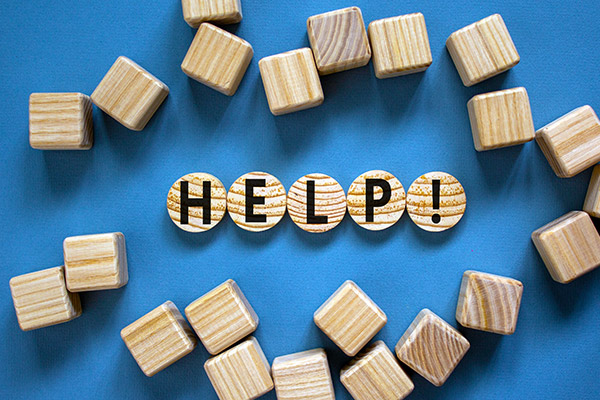
It’s not a regular projector, is it called something?
It’s QKK right from Amazon. That stand is helpful because we can put it up a little bit.
All the moms are taking notes.
Alyssa, what’s your favorite thing?
One of the ways in which cancer has touched my family was skin cancer. My grandmother many years ago had melanoma and nobody detected it. Now, we all go for skin and mole checks and all of that. She didn’t, it got worse, and it was everywhere. That, ultimately, is how she died in her late 60’s. I am someone who definitely is fair skin and needs a lot of sunscreen twelve months out of the year, but I also have sensitive skin.
It’s this thing that I have where I’m always looking for sunscreen that I can put on my face and not have my face wig out. My friend recommended this line. Neocutis is the name of the line. This is called Journée. It’s a day sunscreen and it’s light. It doesn’t do any crazy things to my skin. I have been loving it and using it all summer, especially now I’m trying to be outside as much as possible before winter comes. It has a little bit of a tint to it but nothing too much. It feels like nothing going on. Every day I’ve been using my sunscreen and trying to be good. I got my annual skin exam coming up.
It’s a reminder if you’re reading. A couple of things, you need to do your annual skin checked. If you’re a woman, you need to do your breast exam. Also, Jenna, I’m not sure about you. Did you start having symptoms that you weren’t sure what they were?
Yeah, I was, in the beginning, a little bit of a hypochondriac. When I feels something different then I call the oncologist or my physician. I am on top of all my yearly stuff and even pre-screening for mammograms, ultrasounds, and colonoscopies. I started at 35.
I was going to say that, colonoscopy, especially if it runs in your family, but even if it doesn’t. If you have something that doesn’t feel right, I had three doctors tell me that it was nothing. It didn’t feel right. Finally, we realized what it was. For those of us that have kids, for me anyway, when my kids were sick, they didn’t smell right. I hold them close. They had this distinct, sick smell. I can’t explain it. It’s like a mother bear, I could tell.
For me personally, I could tell something was off. Even though all these people are saying, “You’re fine. You’re a hypochondriac. It’s nothing. It’s stress. It’s this. It’s that.” Someone even told me it was because I was working out too hard that my body was not reacting right to it or something. If you’re having any of those feelings, please go check it out. It doesn’t hurt. Go check it out. My favorite thing is a gratitude jar that my girlfriends gave me. I know it has some money in there because I’m grateful for abundance. I don’t know why it got in there, maybe my kids threw it in there.
Whenever people come over, I was having them fill out these cards as well as myself. This is someone. I don’t know who it is because they didn’t sign it. “I feel grateful for those wonderful, kind, supportive people in my life.” I wrote once, “I’m grateful that you sat in this tight spot.” I don’t know what that means. I guess I sat in a tight spot. Someone said, “I’m grateful for your beauty inside and out.” People that come over say stuff. “My amazing loving and supportive family, love everyone.” This is a gratitude jar. My girlfriends gave it to me for my birthday. It was filled up to the top and then I emptied it and started over again because it’s so nice to reread all of these grateful cards. Jenna, what is your favorite?
I have two. I know I’m not following the instructions.
No, that’s okay.
I have one that’s meaningful and one that’s more frivolous. Similar to Camille, I also was told that I was not going to be able to have children because of how intensive my chemotherapy regimen was. This is my daughter. She also, like your daughter, beats to her own drum. Case and point, at her socially distanced drive-by birthday party, she found a dead snake. She came out wearing a frozen costume and greeted everyone holding the snake in a princess costume. That sums up my daughter in a nutshell.
I have that and then this is totally frivolous, but I’m a candle fiend. To me, creating a safe and nice smelling home is so important. I moved around so much in college and after college that even before I had my furniture, I had a candle burning. It can set a mood, and especially since we’re spending so much time at home. I change it up each day, I light something different. These candles I found to be the most unbelievable, and they’re called Linnea’s Lights. This one is pumpkin. It smells like fall. I got it from a store called Terrain, which is in Philly. It’s where I am. They have antropology. That whole enterprise that owns a bunch of things. They own a store called Terrain, which is a home goods store. It’s got plants and there’s a big nursery, and they have a ton of great candles. That’s where I discovered it. It’s the best. It’ll last forever.
Let’s all light a candle to Jenna. Thank you for shedding light on your journey and everything that we can do to support each other. We’re blessed that you’re here to share this with us. I love hearing about Camille’s and Jenna’s daughters. Deena and I have daughters and that is exactly how it is. You think they’re going to be a certain way and they’re completely different. That’s their journey. Thank you for joining us.
Important Links:
- Twist Out Cancer
- Jenna Benn Shersher – LinkedIn
- Leukemia & Lymphoma Society
- Brushes With Cancer
- Imerman Angels
- Jonny Imerman – Previous episode
- Benji Salter – LinkedIn
- Ethan Zohn
- Jenna@TwistOutCancer.org
- Facebook – Twist Out Cancer
- QKK
- Linnea’s Lights
About Jenna Benn Shersher
 Jenna Benn Shersher, Founder of Twist Out Cancer is a 33-year-old cancer survivor, civil rights advocate, world traveler and tiny twister who dreams big. In December 2010, Jenna was diagnosed with a rare blood disorder called Grey Zone Lymphoma that affects fewer than 300 people in the United States. Instead of surrendering to cancer, she was determined to find meaning in her suffering.
Jenna Benn Shersher, Founder of Twist Out Cancer is a 33-year-old cancer survivor, civil rights advocate, world traveler and tiny twister who dreams big. In December 2010, Jenna was diagnosed with a rare blood disorder called Grey Zone Lymphoma that affects fewer than 300 people in the United States. Instead of surrendering to cancer, she was determined to find meaning in her suffering.
In the course of her fight, Jenna figured out creative ways to leverage social media to process her experience, and in turn, create a community of tiny twisters that became invested in her fight. In the course of a year, Jenna battled cancer and started a nonprofit called Twist Out Cancer—a Support Community. With A Twist. Twist Out Cancer changes the way a survivor shares and the way a community gives.
To date, over 35,000 people have twisted out cancer. Jenna is a blogger for the Huffington Post and Oy Chicago and has made television appearances on CNN, NBC5, CBS, ABC7 and Fox News. She has also been featured in the New York Times, Mashable, LA Times, Wall Street Journal, Chicago Tribune and Chicago Sun Times. Jenna is a mentor angel with Imerman’s angels and serves on the Patient Advisory Board of Northwestern Hospital. In addition, she is an Honored Hero and advocates for Team in Training and the Leukemia and Lymphoma Society.
When Jenna isn’t twisting, you can find her working full-time at the Anti-Defamation League where she oversees young leadership programming, media and PR and international affairs advocacy.
On November 6, 2014, over 120 people joined Twist Out Cancer for our official kick-off party titled “Brushes With Cancer: Pairing Artists with Those Touched by Cancer to Create for a Cause,” at the Matthew Rachman Gallery in Chicago Illinois. Brushes With Cancer is a four-month program that matches artists with those touched by cancer. This unique celebration of survivorship and hope pairs those touched by cancer (previvors, survivors and caregivers) with talented artists working in a variety of mediums.
Those touched by cancer share their ‘twist on cancer’—lessons learned, fighting strategies, and new perspectives—with their respective artist. These “twists” serve as the inspiration for the unique pieces of artwork that are created in their honor.
The program culminates with a celebratory annual event and fundraiser in which the pairs connect in person and the artwork is revealed for the first time.
Love the show? Subscribe, rate, review, and share!
